The best time to travel to the Great Barrier Reef is generally from June to November, offering ideal conditions for exploring this natural wonder. SIXT.VN understands planning a trip can be overwhelming, so we provide comprehensive travel and tourism services in Vietnam, including personalized itineraries and reliable transportation. Discover the best time to visit and how we can make your trip unforgettable with our travel services.
1. What Is The Best Time of Year to Visit the Great Barrier Reef for Optimal Weather?
The best time to visit the Great Barrier Reef for optimal weather is generally from June to November. During these months, you’ll experience lower rainfall, reduced humidity, and comfortable temperatures, making it ideal for diving, snorkeling, and exploring the reef. According to the Bureau of Meteorology, this period avoids the intense heat and wet season that occurs from December to March. This season offers the best visibility underwater and the lowest risk of cyclones. In comparison, the wet season brings oppressive heat and heavy rainfall, which can impact visibility and accessibility to certain areas of the reef. Therefore, planning your visit between June and November ensures the most enjoyable experience.
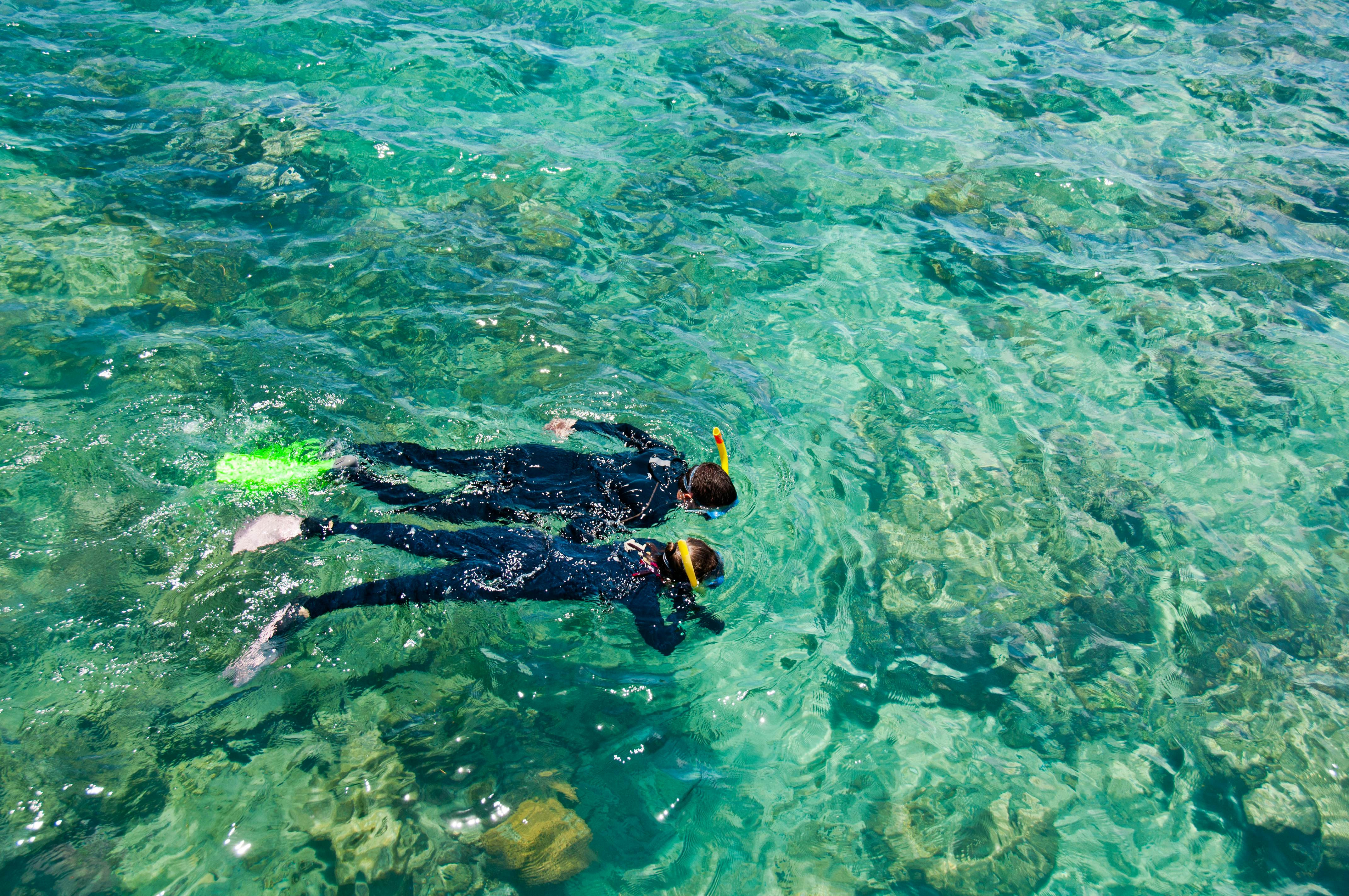 Snorkelers, Great Barrier Reef, Australia
Snorkelers, Great Barrier Reef, Australia
2. How Does Stinger Season Affect Travel to the Great Barrier Reef?
Stinger season, which runs from November to May, affects travel to the Great Barrier Reef by increasing the risk of jellyfish stings. During these months, box jellyfish and Irukandji jellyfish are more prevalent in the waters. To mitigate this risk, many tour operators provide Lycra stinger suits for snorkelers and divers. According to the Queensland Government, wearing protective clothing significantly reduces the chance of being stung. Despite the stinger season, many visitors still travel to the reef, taking necessary precautions and enjoying the underwater scenery. Areas like the Whitsundays and the southern Great Barrier Reef are generally less affected by stingers, making them viable options year-round.
3. What Are the Best Months to See Whale Migration at the Great Barrier Reef?
The best months to see whale migration at the Great Barrier Reef are during the winter months of June to October. Humpback whales migrate to the warmer waters of the reef to breed and calve. During this time, whale watching tours offer incredible opportunities to witness these magnificent creatures. According to the Great Barrier Reef Marine Park Authority, this is the peak period for whale sightings. Areas like Hervey Bay, though not directly on the reef, serve as a significant stopover for whales during their migration. Seeing these whales in their natural habitat is an unforgettable experience, making winter an excellent time to plan your visit.
4. When Is Turtle Nesting and Hatching Season at the Great Barrier Reef?
Turtle nesting and hatching season at the Great Barrier Reef occurs from November to April. During this period, sea turtles, including Green and Loggerhead turtles, come ashore to lay their eggs. After about two months, the hatchlings emerge and make their way to the ocean. According to the Department of Environment and Science, Queensland, Mon Repos Conservation Park near Bundaberg is a prime location to witness this natural phenomenon. Ranger-led tours provide a safe and educational experience, allowing visitors to observe the nesting and hatching process. This season is a remarkable time to visit the reef and witness the incredible life cycle of these marine creatures.
5. Where Can I See Manta Rays at the Great Barrier Reef, and When Is the Best Time?
Manta rays are abundant around Lady Elliot Island, located in the southern Great Barrier Reef. The best time to see manta rays is during the Australian winter, from May to August. Lady Elliot Island is known as the “Home of the Manta Ray,” and offers exceptional opportunities for snorkeling and diving with these gentle giants. According to the Lady Elliot Island Eco Resort, the cooler months attract the highest concentration of manta rays due to plankton blooms, their primary food source. The island’s clear waters and dedicated eco-tourism practices ensure a memorable and sustainable experience.
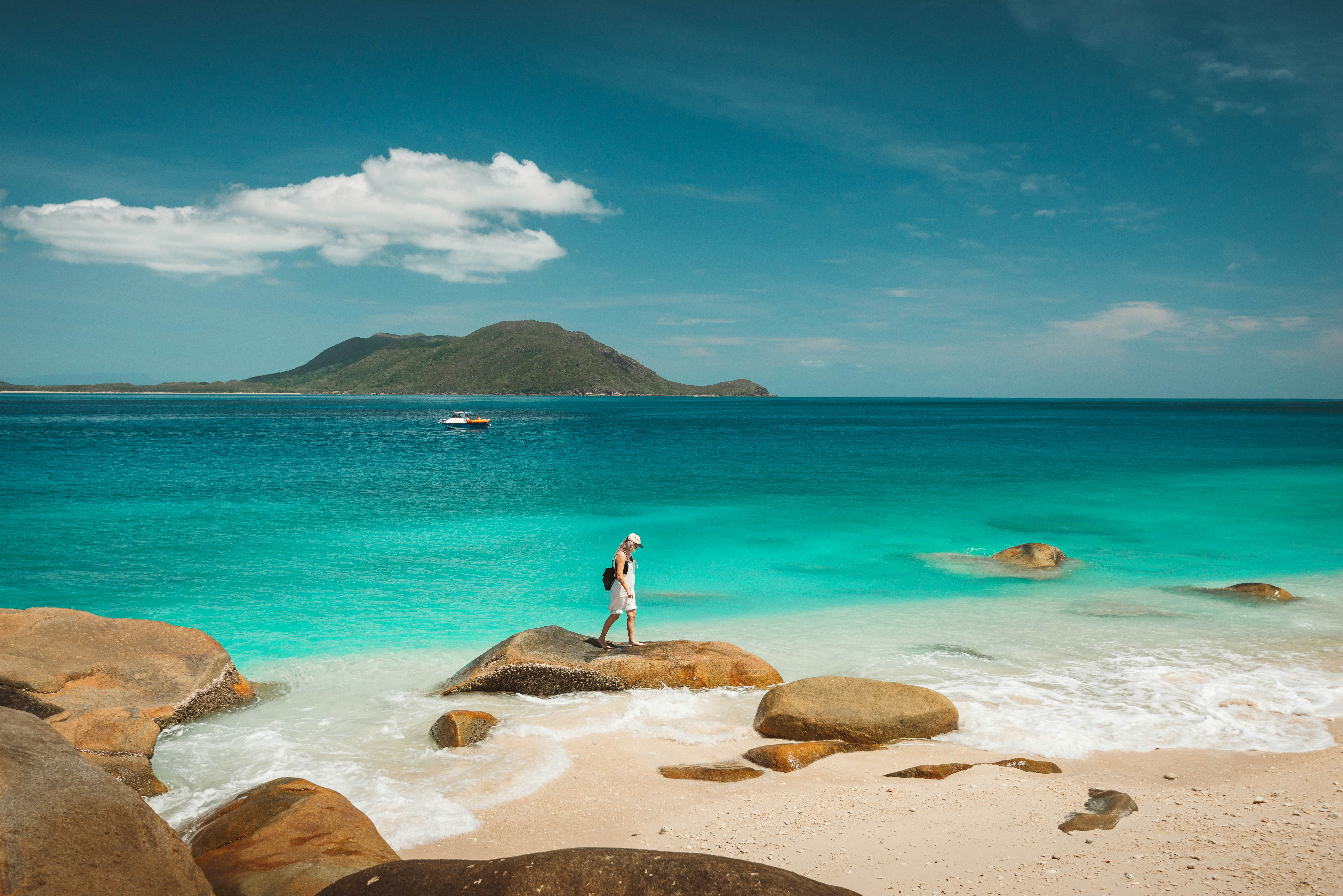 Nudey beach on Fitzroy island near Cairns in Queensland, Australia
Nudey beach on Fitzroy island near Cairns in Queensland, Australia
6. How Long Should I Plan to Spend at the Great Barrier Reef to Get the Most Out of My Trip?
To get the most out of your trip to the Great Barrier Reef, plan to spend at least three to seven days. A few hours might suffice for a brief glimpse from a land-based hub, but a more immersive experience requires more time. A full day trip is essential to explore the outer reef’s impressive diving and snorkeling spots. According to Tourism Australia, extending your stay allows you to visit multiple locations and experience different aspects of the reef. For diving enthusiasts, liveaboard dive boats offer trips ranging from one to seven nights, accessing the most spectacular reefs. In the Whitsundays, sailing trips typically run for two nights and three days, combining snorkeling with optional introductory dives.
7. Is It Possible to Stay Overnight on the Great Barrier Reef, and What Are My Options?
Yes, it is possible to stay overnight on the Great Barrier Reef, with several options available. You can stay on one of the many islands and coral cays, such as Lizard Island, Green Island, Fitzroy Island, Hamilton Island, Heron Island, Wilson Island, and Lady Elliot Island. These island resorts offer a unique experience of waking up with the reef right at your doorstep. According to Queensland Tourism, these resorts provide various accommodation options, from luxury suites to family-friendly bungalows. You can also stay in pontoon-based accommodation managed by companies like Cruise Whitsundays and Lady Musgrave Experience. These pontoons offer comfortable lodging and easy access to snorkeling and diving sites.
8. What Are the Main Access Points to the Great Barrier Reef, and How Easy Are They to Reach?
The main access points to the Great Barrier Reef include Cairns, Port Douglas, Mission Beach, Townsville, Airlie Beach, Bundaberg, Mackay, Yeppoon, Gladstone, Agnes Water, and the town of 1770. Cairns and Port Douglas are the most popular, offering numerous tour operators and easy access to the reef. According to the Great Barrier Reef Foundation, Cairns has an international airport with transfers to Port Douglas. Most hubs have domestic airports, and the Spirit of Queensland rail connects Brisbane to Cairns. Boat trips to the outer reef typically take 90 to 120 minutes. Large catamarans, which reduce the likelihood of seasickness, depart from Cairns, Port Douglas, the Whitsundays, and Bundaberg.
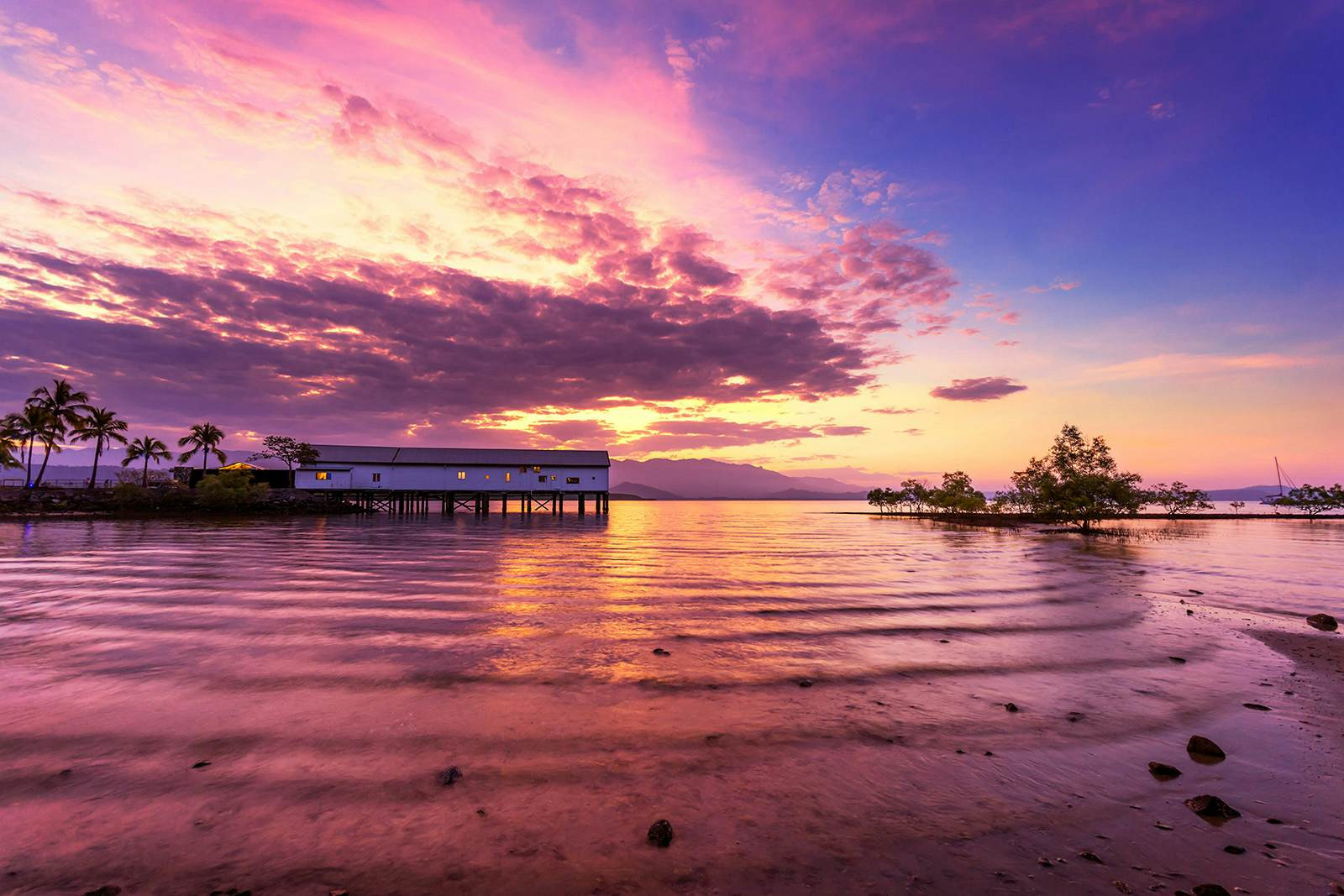 Sugar Wharf in Port Douglas. Photo by Stoneography / Getty.
Sugar Wharf in Port Douglas. Photo by Stoneography / Getty.
9. What Activities Can I Do at the Great Barrier Reef Besides Diving and Snorkeling?
Besides diving and snorkeling, there are numerous activities you can enjoy at the Great Barrier Reef. Scenic flights in small planes or helicopters from Cairns or the Whitsundays offer breathtaking views of the reef. Non-swimmers can view the reef from glass-bottom boats, semi-submersibles, and underwater observatories at pontoons visited on day trips. According to Lonely Planet, sailing tours in the Whitsundays provide a relaxing way to experience the island scenery. On land, Indigenous-guided tours offer insights into how Aboriginal and Torres Strait Islander peoples have lived in harmony with the reef for centuries. You can also visit the Daintree Rainforest from Cairns and Port Douglas or learn about sea turtles at Bundaberg’s Mon Repos Turtle Centre.
10. Which Locations on the Great Barrier Reef Are Most Suitable for Families with Children?
Cairns and Port Douglas are popular choices for families due to their abundance of family-friendly resorts and reef tour options. In the Whitsundays, Hamilton Island and Daydream Island Resort offer family-friendly island bases. Airlie Beach has a wide range of caravan parks for road-tripping families. Many boat trips visit family-friendly pontoons, such as Reef Magic near Cairns. According to Reef Magic Cruises, these pontoons offer activities for all ages, including semi-submarines, glass-bottom boats, and underwater observatories. Nervous snorkelers can view fish without leaving the platform, ensuring a safe and enjoyable experience for everyone.
11. How Much Should I Budget for a Trip to the Great Barrier Reef?
A standard day trip to the outer reef, including snorkeling gear, lunch, and glass-bottom boat tours, costs between AUD $200 to AUD $350 per adult, with family rates available. Scuba dives can be added for an extra cost, typically around AUD $200 for two dives. According to Budget Your Trip, the best deals are usually found in Cairns due to the wider choice of operators. Half-day trips to the inner reef can save time and money. Camping on islands in Great Barrier Reef national parks, such as Capricornia Cayes National Park, Fitzroy Island National Park, and Whitsunday Islands National Park, is an affordable option at AUD $7.25 per night, though boat transfers can increase the cost.
12. Where Are the Best Spots for Diving and Snorkeling on the Great Barrier Reef?
Great diving and snorkeling can be found along the entire length of the Great Barrier Reef, offering a rich diversity of corals, tropical fish, turtles, rays, and sharks. While the corals are more vibrant northward of Townsville, the southern Great Barrier Reef is less prone to coral bleaching and a great place to see manta rays. According to the GBRMPA, liveaboard trips from Cairns access the most exquisite sections of the outer reef, including the Ribbon, Osprey, Milln, Bougainville, and Holmes reefs. Day trips often visit Agincourt Reef off Port Douglas and John Brewer Reef off Townsville. The SS Yongala wreck near Townsville is considered one of the world’s top wreck dives.
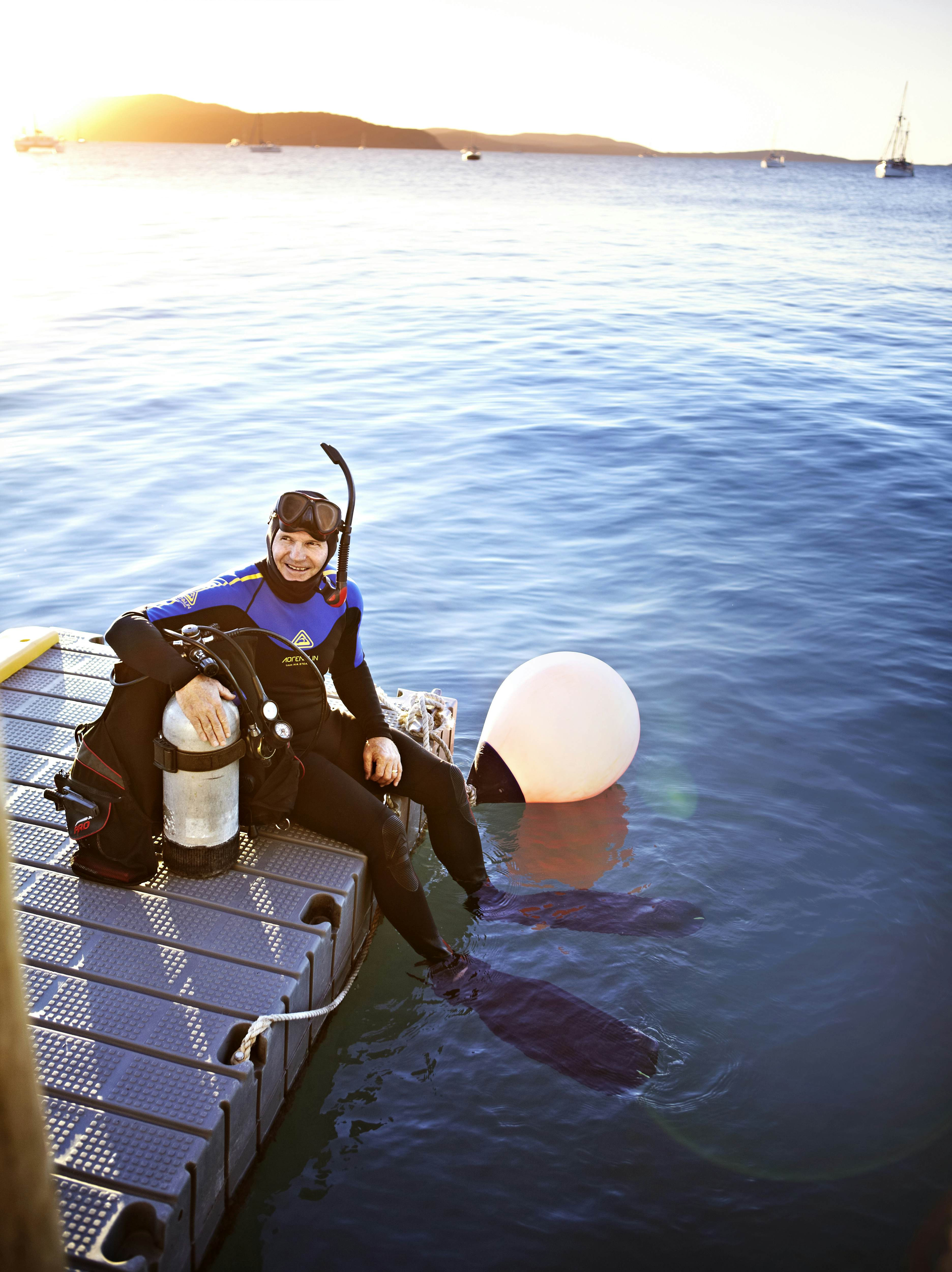 Portrait of Great Barrier Reef dive instructor
Portrait of Great Barrier Reef dive instructor
13. Can I Get Scuba Certified While Visiting the Great Barrier Reef?
Yes, you can get scuba certified while visiting the Great Barrier Reef. The main learning centers are in Cairns, with open water courses offered by operators like ProDive Cairns. These courses typically include two days of pool and classroom training, followed by two days of reef diving on day trips, or three days of diving on a two-night liveaboard trip. According to PADI, advanced courses are often hosted on liveaboards. This allows you to combine learning with exploring the reef’s stunning underwater landscapes.
14. What Is the Current State of the Great Barrier Reef, and What Threats Does It Face?
The Great Barrier Reef faces unprecedented threats, including coral bleaching caused by heat stress. Approximately 73% of the reefs surveyed in the summer of 2023/24 were impacted by coral bleaching. Other threats include coral-hungry crown-of-thorns starfish, cyclones, flooding, land-based run-off, and marine pollution. According to the Australian Institute of Marine Science, while some parts of the reef have suffered, others have shown resilience and recovery. Visitors can help monitor changes by reporting observations via the Eye on the Reef app and supporting conservation efforts through citizen science-based tours.
15. What Should I Pack for a Trip to the Great Barrier Reef to Ensure I Am Prepared?
When packing for a trip to the Great Barrier Reef, sun protection is essential. Choose reef-safe sunscreen brands that use physical UV blockers like zinc oxide and titanium dioxide. Pack warm layers and rain gear regardless of the weather forecast. If you plan on snorkeling or diving, consider bringing your own gear to save on rental costs. According to Travel + Leisure, other essentials include a hat, sunglasses, swimwear, a rash vest, and a waterproof camera.
16. What Accessible Travel Options Are Available at the Great Barrier Reef for People with Disabilities?
The Cairns region offers the widest range of accessible accommodation, reef tours, and attractions with wheelchair access. Support is available for visitors with vision and hearing difficulties or other needs. According to Tropical North Queensland Tourism, accessible tours and facilities are designed to provide inclusive experiences for all visitors. Contact tour operators in advance to confirm accessibility features and make necessary arrangements.
17. How Can I Stay Safe While Visiting the Great Barrier Reef, and What Precautions Should I Take?
Tourism in the Great Barrier Reef Marine Park is tightly managed to ensure visitor safety and protect the reef. Follow safety instructions and avoid touching coral and marine life. While shark encounters are rare, jellyfish stings can be avoided by wearing a stinger suit during stinger season. Outside stinger season, a rash vest or wetsuit can help prevent contact with stinging critters like sea lice. Saltwater crocodiles are present along the coast, so stick to designated swimming areas. According to the GBRMPA, being aware and following guidelines helps ensure a safe and enjoyable visit.
18. What Unique Experiences Can I Have at the Great Barrier Reef That Go Beyond the Typical Tourist Activities?
Beyond the typical tourist activities, you can have unique experiences like staying at eco-friendly resorts on the reef’s southern tip. These resorts often run entirely on solar power and offer opportunities to snorkel with turtles, dive with manta rays, and observe rare seabirds. According to Queensland.com, participating in citizen science tours can also provide a deeper understanding of the reef’s ecosystem and conservation efforts.
19. What Conservation Efforts Are in Place to Protect the Great Barrier Reef, and How Can I Contribute?
Various conservation efforts are in place to protect the Great Barrier Reef, including monitoring programs, crown-of-thorns starfish control, water quality improvement initiatives, and climate change mitigation strategies. According to the Great Barrier Reef Foundation, you can contribute by reporting bleaching observations via the Eye on the Reef app, supporting eco-tourism operators, reducing your carbon footprint, and donating to conservation organizations. Your actions can make a difference in preserving this natural wonder for future generations.
20. How Does SIXT.VN Enhance the Travel Experience to the Great Barrier Reef?
SIXT.VN enhances the travel experience to the Great Barrier Reef by offering comprehensive and reliable travel services tailored to your needs. From personalized itineraries to convenient airport transfers and comfortable accommodations, SIXT.VN ensures a stress-free journey. Our local expertise and commitment to quality mean you can focus on enjoying the beauty and wonder of the Great Barrier Reef. According to customer reviews, SIXT.VN’s attention to detail and exceptional customer service make all the difference, transforming a simple trip into an unforgettable adventure. Let SIXT.VN handle the logistics, so you can immerse yourself in the magic of the Great Barrier Reef.
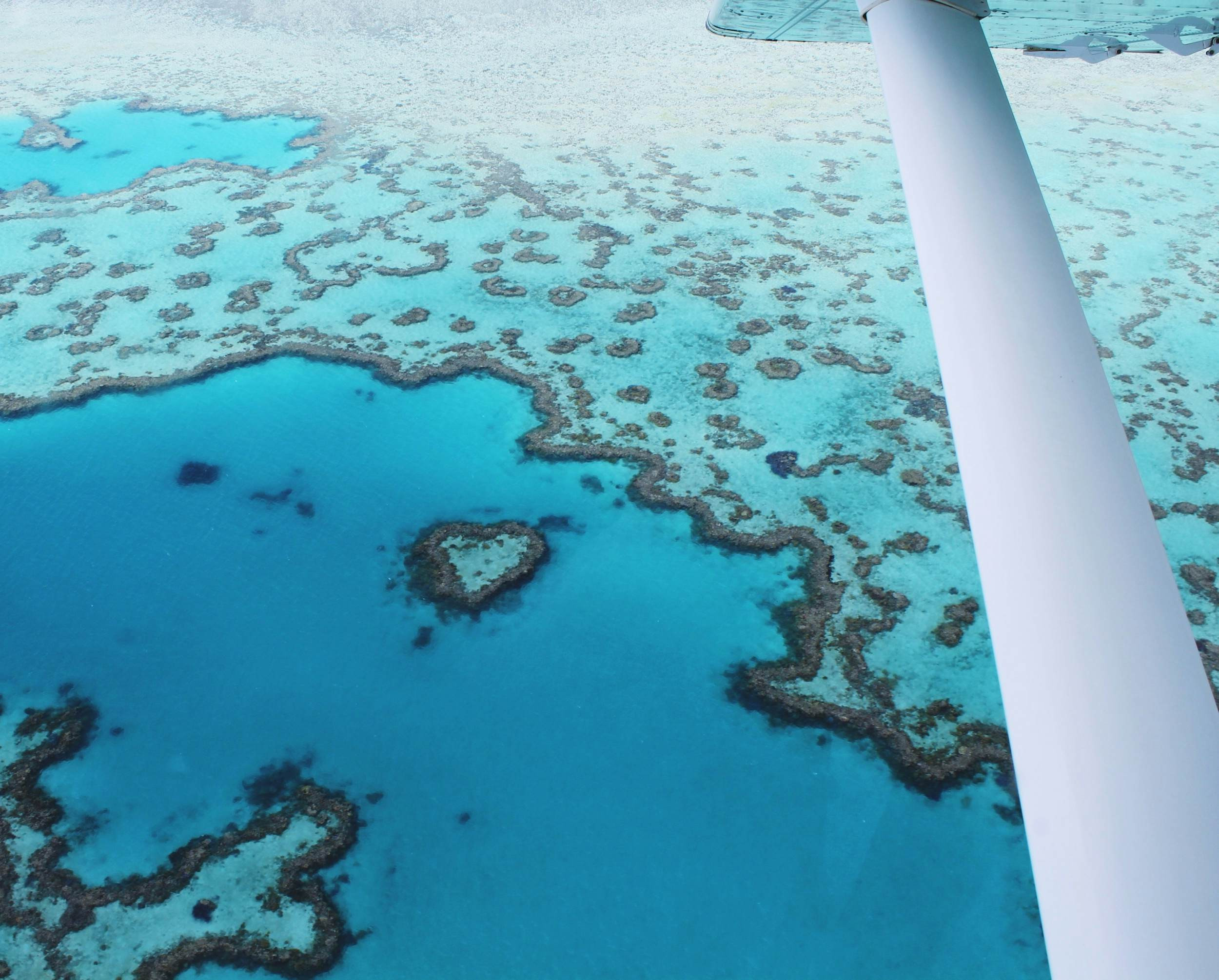 Plane view of the famous Heart Reef (Great Barrier Reef) at the coastline of Airlie Beach near the Whitsunday Islands (Whitsunday Islands, Australia)
Plane view of the famous Heart Reef (Great Barrier Reef) at the coastline of Airlie Beach near the Whitsunday Islands (Whitsunday Islands, Australia)
21. What Indigenous Cultural Experiences Are Available at the Great Barrier Reef?
Indigenous-guided tours offer a memorable opportunity to learn how Aboriginal and Torres Strait Islander peoples have lived in harmony with the reef for time immemorial. Dreamtime Dive and Snorkel in Cairns provides day trips exploring the reef with Indigenous guides, sharing ancient stories and traditions. According to Tourism Australia, these tours offer a deeper connection to the land and sea, enhancing your understanding and appreciation of the reef’s cultural significance. Engage with local communities to gain unique insights into the reef’s history and its importance to Indigenous cultures.
22. What Options Are Available for Sustainable and Eco-Friendly Travel to the Great Barrier Reef?
Sustainable and eco-friendly travel options to the Great Barrier Reef include choosing eco-certified tour operators, staying at eco-resorts, and participating in conservation activities. Eco-certified operators follow best practices to minimize their environmental impact, such as using reef-safe sunscreen and reducing waste. Lady Elliot Island Eco Resort is a prime example of sustainable accommodation, running almost entirely on solar power and promoting eco-tourism. According to Ecotourism Australia, supporting these initiatives helps protect the reef’s delicate ecosystem. Reduce your environmental footprint by making conscious choices that benefit the reef’s long-term health.
23. How Does the Weather Vary Across Different Regions of the Great Barrier Reef, and How Should I Prepare?
The weather varies across different regions of the Great Barrier Reef. The northern regions, like Cairns and Port Douglas, experience a tropical climate with a distinct wet season from December to March. The southern regions, like the Whitsundays and Bundaberg, have a subtropical climate with more moderate temperatures year-round. According to the Bureau of Meteorology, it’s essential to check the weather forecast before your trip and pack accordingly. In the wet season, prepare for high humidity, heavy rainfall, and potential cyclones. In the dry season, pack light clothing, sunscreen, and a hat to protect yourself from the sun.
24. What Emerging Technologies and Innovations Are Being Used to Protect and Restore the Great Barrier Reef?
Emerging technologies and innovations are being used to protect and restore the Great Barrier Reef, including coral reseeding, robotic starfish control, and cloud brightening. Coral reseeding involves growing coral fragments in nurseries and transplanting them onto damaged reefs. Robotic starfish control uses robots to inject crown-of-thorns starfish with a substance that kills them. Cloud brightening aims to increase the reflectivity of clouds to reduce ocean temperatures and prevent coral bleaching. According to the Great Barrier Reef Foundation, these technologies offer promising solutions to combat the threats facing the reef. Support these innovations to help ensure the reef’s survival.
25. What Are the Best Ways to Experience the Great Barrier Reef on a Budget Without Sacrificing Quality?
To experience the Great Barrier Reef on a budget without sacrificing quality, consider camping on islands in national parks, taking half-day trips to the inner reef, and visiting during the shoulder season. Camping is an affordable accommodation option, with rates around AUD $7.25 per night. Half-day trips offer a shorter and more economical way to see the reef. The shoulder season (April-May and September-October) provides a balance of good weather and lower prices. According to Tourism Queensland, planning your trip carefully and looking for deals can help you enjoy the reef without breaking the bank.
SIXT.VN is committed to making your trip to Vietnam and the Great Barrier Reef seamless and unforgettable.
Ready to explore the Great Barrier Reef? Contact SIXT.VN today for personalized travel itineraries, reliable airport transfers, and comfortable hotel bookings. Let us take care of the details, so you can focus on creating lasting memories.
Address: 260 Cau Giay, Hanoi, Vietnam
Hotline/Whatsapp: +84 986 244 358
Website: SIXT.VN
FAQ: Frequently Asked Questions About Visiting the Great Barrier Reef
1. When is the best month to visit the Great Barrier Reef?
The best months to visit the Great Barrier Reef are June to November for optimal weather and visibility.
2. Do I need a stinger suit when visiting the Great Barrier Reef?
Yes, during the stinger season (November to May), wearing a stinger suit is recommended to protect against jellyfish stings.
3. Can I stay on an island on the Great Barrier Reef?
Yes, several islands offer accommodations, including Lizard Island, Green Island, and Hamilton Island.
4. What activities can I do on the Great Barrier Reef?
Besides diving and snorkeling, you can take scenic flights, visit underwater observatories, and go sailing.
5. How much does a day trip to the Great Barrier Reef cost?
A day trip to the outer reef typically costs between AUD $200 and AUD $350 per adult.
6. What is the best way to see manta rays at the Great Barrier Reef?
Visit Lady Elliot Island during the Australian winter (May to August) for the best chance to see manta rays.
7. Is scuba diving certification available at the Great Barrier Reef?
Yes, scuba diving courses are available in Cairns, with options for open water and advanced certifications.
8. How can I contribute to conserving the Great Barrier Reef?
Report bleaching observations, support eco-tourism operators, and donate to conservation organizations.
9. What should I pack for a trip to the Great Barrier Reef?
Pack reef-safe sunscreen, warm layers, rain gear, and your own snorkeling or diving gear.
10. Are there accessible travel options for people with disabilities?
Yes, the Cairns region offers accessible accommodations, tours, and attractions for visitors with disabilities.



